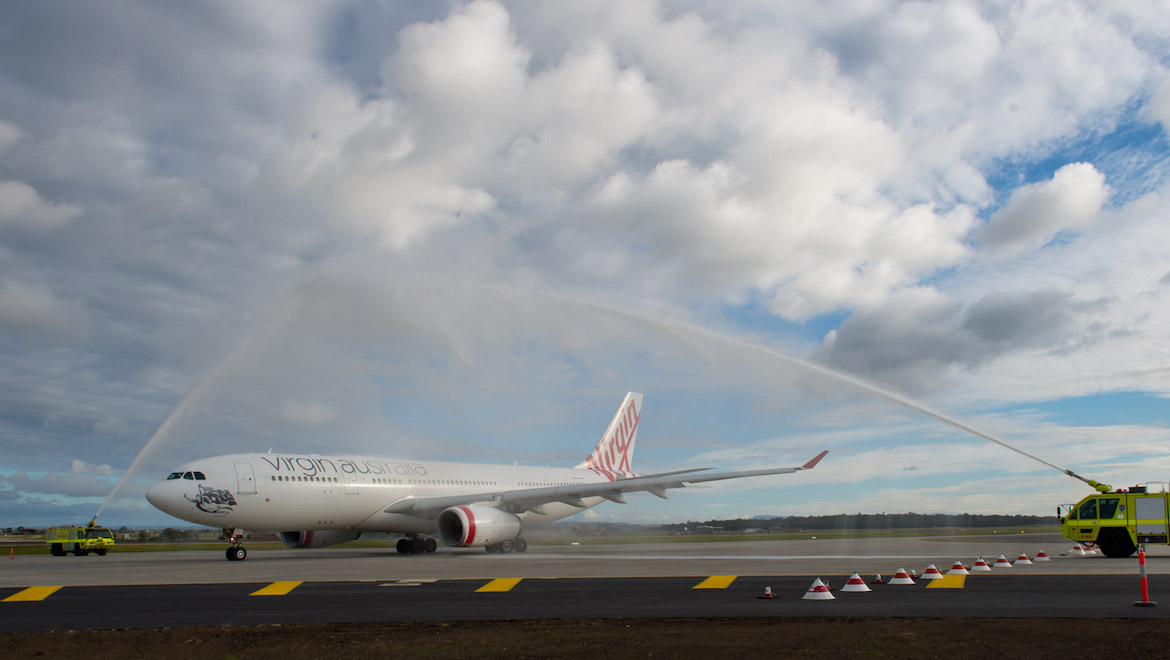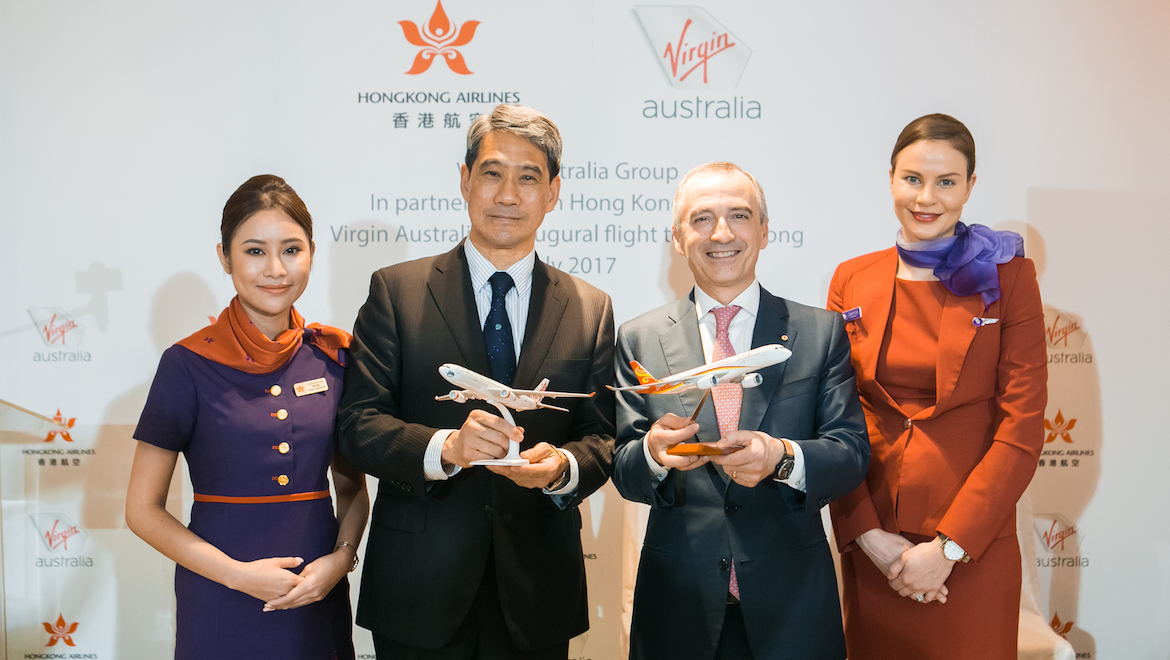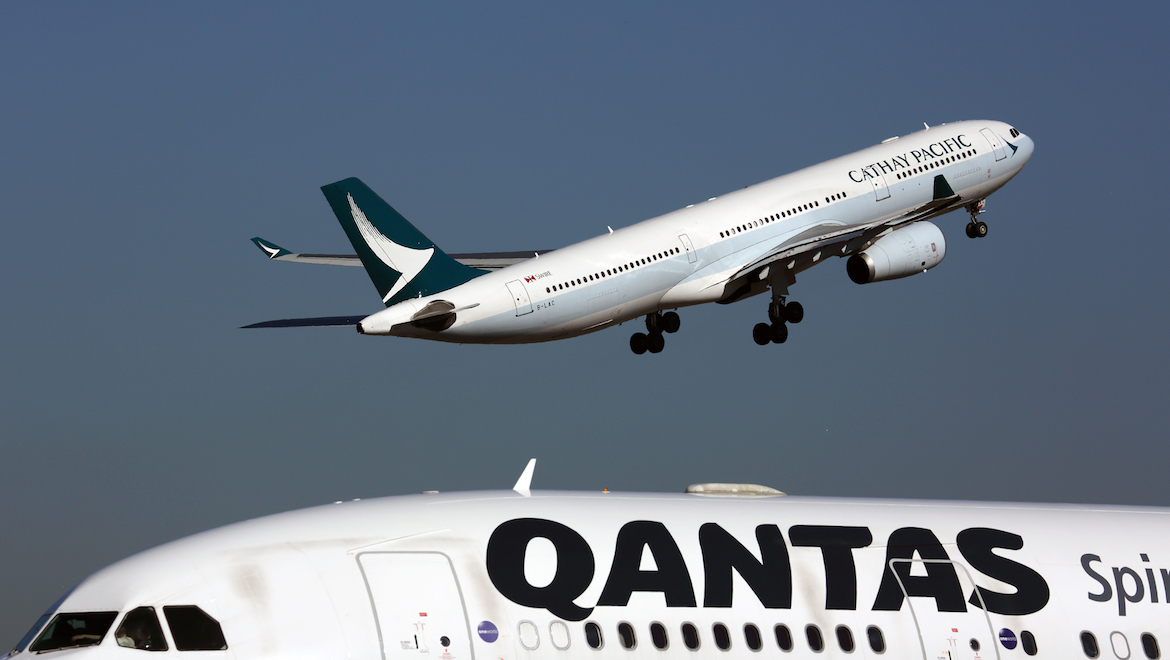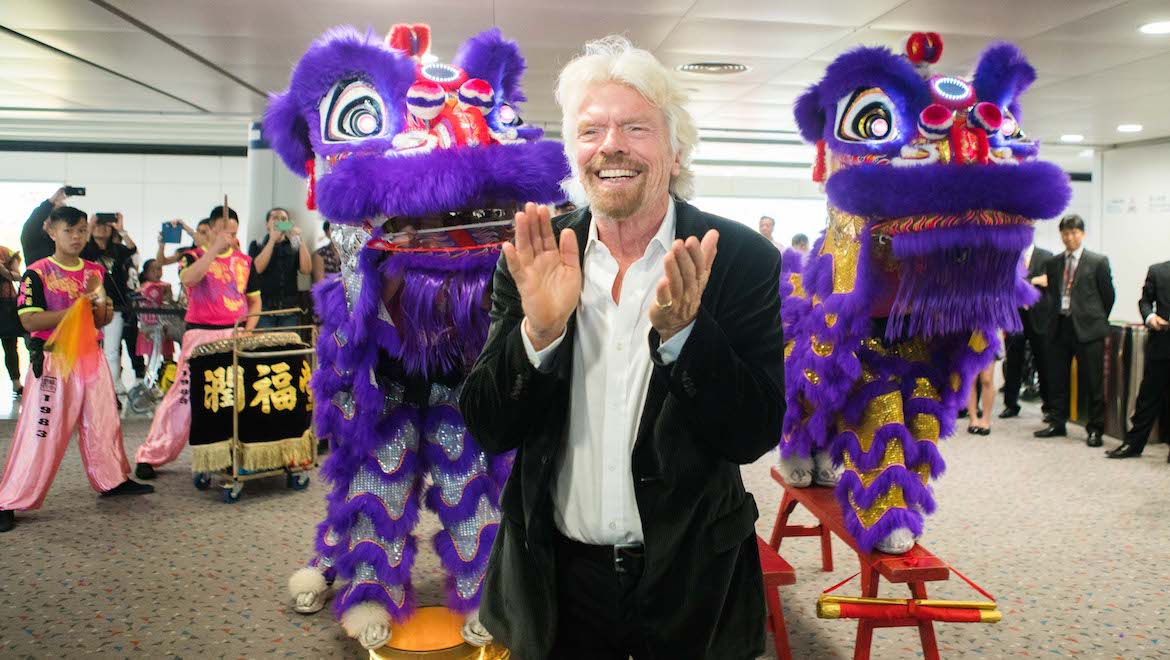To mark the two-year anniversary of Virgin Australia starting flights to Hong Kong on July 5, this week’s story from the Australian Aviation archives is from August 2017, when Jordan Chong wrote about the airline’s commencement of Melbourne-Hong Kong services.

Virgin Australia chief executive John Borghetti says he is encouraged by the initial response to the airline’s expansion into Asia and is keen to tap into unmet demand with more flights to Hong Kong and new services to China.
Following a quick three-month launch, Virgin’s inaugural Melbourne-Hong Kong service took off on July 5, with Borghetti joined by UK-based Virgin Group founder Sir Richard Branson, politicians, other invited guests and paying customers on board.
It marked what Borghetti termed the start of Virgin’s “spearhead” into Asia, with the initial five times a week service a beachhead for future expansion to a city that sits within five hours of half the world’s population.
Amid the smiles and celebrations of the first flight, including some typically abrasive comments from Sir Richard towards local rival Qantas, the reality is Virgin faces some formidable – though not insurmountable – challenges if it is to turn Hong Kong into a successful new hub alongside its eventual entry into mainland China.
These centre on available aviation capacity in Hong Kong, the competitive strength of the incumbent operators and flexibility in Virgin’s fleet to support growth in these new markets.
It is worth looking at each in turn.
Slots
Clearly, Virgin would have preferred to have a daily service in place when its Airbus A330-200s started operating to Hong Kong.
However, it was granted only five slots a week and had to offer a split schedule featuring both morning and late night departures from Melbourne, depending on the day of operation.
Not only does that diminish the appeal of the service for business travellers, who are looking for schedule consistency and daily flights, it also hurts fleet utilisation, given on some days the A330s sit idle at Hong Kong for up to 11 hours.
Speaking at Melbourne Airport ahead of getting on board the July 5 inaugural service, Sir Richard revealed Virgin had applied for 21 new slots in Hong Kong to hopefully cover not just Melbourne but potentially also Sydney and Brisbane.
“We will hope that in the next slot committee that we manage to get enough to get at least one of those two routes up and running,” said Sir Richard, who holds no official management role at Virgin Australia and does not sit on the airline’s board. (Virgin Group does hold about eight per cent of Virgin Australia shares and has a seat on the board.)
The next day, a still energised Borghetti confirmed the desire for more slots when speaking with reporters during a media conference at Hong Kong’s The Peninsula Hotel.
“It’s so exciting to be flying into one of the world’s best cities. There is no doubt that the excitement of this city rubs off on you very, very quickly,” Borghetti said.
“Obviously today we only have five slots but really would like some more, and the moment we have more slots then we will allocate them to various cities.
“But the very first city that we have to arrange is for Melbourne to go to daily. Once we have Melbourne daily then we can look at, I won’t say which ones I’ll give you an idea though, Sydney and Brisbane and perhaps even more than that.
“The only thing limiting us really in terms of growing the flights is just slots because you can’t land.”
While having a local partner may offer some assistance, Hong Kong Airlines vice chairman Tang King-shing highlighted the difficulty all carriers are facing in Hong Kong ahead of the third runway being completed in 2024.
“Business is business,” Tang said during the July 6 media conference.
“An airline’s expansion, connectivity and partnership is important but looking after number one has to be our priority.
“Of course having looked after our number one, having looked after our core routes and business, if we see a need and we also see the viability of sharing slots so that we can together create better synergy we will be happy to do that.”
On this point, Borghetti said he and Tang were of the same view.
“I agree 100 per cent with what Mr Tang said,” Borghetti said.
“I believe very much in relationships that both parties win, not one takes the other one gives. You know, you both have to understand each other’s individual priorities.”
Hong Kong-based senior analyst at aviation thinktank CAPA – Centre for Aviation Will Horton said slot allocation in both Hong Kong and mainland China is not particularly transparent.
“Virgin Australia may wish to use 21 weekly slots and could do so, but there’s certainly a tactical play that they know whatever they apply for they will not receive in full. So the more they apply for, the more they’ll get,” Horton told Australian Aviation.
“Hong Kong’s slots are basically full at peak hours. There are new slots being created but these are still well below demand. The allocation process for available slots is opaque.”
Borghetti confirmed plans to operate into mainland China “shortly”, without offering details on the routes under consideration.
“These are complex things,” Borghetti said.

Incumbents are formidable opponents
Virgin’s five flights a week pale in comparison to the frequencies offered by Cathay Pacific and Qantas, which Borghetti said in February had the market “by the throat”.
Hong Kong-based Cathay flies up to 70 flights a week to six Australian destinations – Adelaide, Brisbane, Cairns, Melbourne, Perth and Sydney – while Qantas has up to 28 flights a week from Brisbane, Melbourne and Sydney.
On Melbourne-Hong Kong, Cathay is up to three times daily in peak times, while Qantas offers a daily service. And the pair’s flights between Australia and Hong Kong are full.
Figures from the Bureau of Infrastructure, Transport and Regional Economics show that in 2016 Cathay’s average load factor for inbound flights to Australia was 88.3 per cent, while the outbound average load factor was 88.5 per cent, among the highest for any carrier serving this country.
Meanwhile, Qantas’s services to and from Hong Kong had average load factors of 80.9 per cent inbound and 77.6 per cent outbound.
The only other operator in the Australia-Hong Kong market is Virgin’s alliance partner Hong Kong Airlines, which has a handful of flights to Cairns and the Gold Coast each week. Its flights had inbound average load factors of 67.4 per cent and outbound average load factors of 68.6 per cent in calendar 2016.

Certainly the Hong Kong Tourism Board was full-throated in its praise of Virgin’s new flights, noting it would contribute to an 8.3 per cent increase in seat numbers in 2017.
“We are delighted to have Virgin Australia join us on the route from Melbourne to Hong Kong,” Hong Kong Tourism Board regional director Andrew Clark told reporters at Tullamarine.
“We certainly welcome the added capacity and obviously the added competition. We love that. We know that will be good for consumers.”
Tourism Australia managing director John O’Sullivan also saw much potential in Virgin’s Hong Kong operations.
“Over the next few months you will see us working hand in glove with Virgin Australia in talking about Australia as a destination,” O’Sullivan told reporters in Hong Kong.
“The first thing is a fully integrated campaign across digital platforms, out of home advertising, trade and media familiarisations over the next three months.
“In addition to that we will be developing new content starting with our partners at TVB and a 10-episode, 30-minute programming highlighting the intricacies and uniqueness of Melbourne as a destination which we think is so very important supporting this very new service.”
Virgin’s arrival on the route has certainly elicited a response from the incumbents, who although members of the oneworld marketing alliance do not cooperate in the Australia-Hong Kong market and are fierce competitors for both point-to-point and sixth freedom traffic.
Figures from Virgin indicated ticket prices from Cathay and Qantas on the Melbourne-Hong Kong route had fallen by as much as 34 per cent in response to the airline’s entry into the market.
Borghetti said the the data confirmed competition was desperately needed on that route.
“The second thing that it proves is that the seat factors were very high and consequently the airfares were very high and I think that competitive advantage doesn’t just stop at price,” Borghetti said.
“It also comes with service and product and we can match that and better it.”

Asked how ticket sales had been since reservations opened in March, Borghetti said the load factor on the inaugural service was about 80 per cent, while Australia-bound services were “in the 90s” for the first week of operations.
This highlighted the pent up demand on the route, he said.
“I’m not going to comment further than that because we start getting into competitive information that I don’t want to divulge,” Borghetti said.
“But I think it is enough to give you an indication that even with a short lead time there’s been huge demand for us. That gives us heart to believe it is going to be successful.
“That’s why we are so focused on hoping to get more slots because we can see that the demand is pent up.”
In addition to the passenger market, Borghetti said the Hong Kong flights would also open up opportunities on the cargo side.
“As I look forward to the cargo booking window over the next couple of weeks or so, I am already seeing some pretty significant loads,” Borghetti said.
“Now a lot of it is perishables – I used the example last night of taking fresh salmon from the Tasmanian waters right up to the restaurant here and on your plate within 24 hours.”
Virgin is selling connections beyond Hong Kong thanks to a codeshare agreement with Hong Kong Airlines that, at this stage, covers 11 destinations across the two airline networks and interline connections into mainland China. It is part of a broader alliance with HNA Group carriers that received Australian Competition and Consumer Commission (ACCC) draft approval in June.
Bilateral restrictions prevent codesharing between Hong Kong and mainland China.
Virgin has also struck a reciprocal frequent flyer agreement with four HNA Group carriers – Hong Kong Airlines, Hainan Airlines, Capital Airlines and Tianjin Airlines – that offers points and status earning, as well as redemption opportunities, on eligible flights.
Benefits such as lounge access, priority handling and additional baggage allowance would be part of a second phase of the agreement due to be announced at a future date.
Hong Kong Airlines’ Tang, a former Hong Kong police commissioner, described Virgin as “one of our very important partners indeed”.
“Under the alliance agreement we are happy to provide Virgin Australia an expanded reach through Hong Kong to mainland China,” Tang said.
“It also boosts Hong Kong Airlines’ global expansion strategy in transforming from a regional airline to an international carrier.
“This strategic alliance is a shared vision of both VA and Hong Kong Airlines to benefit our customers who are looking for more travel options and seamless connectivity. You will see how we join hands and do it better.”

While Virgin is able to, slots pending, move forward on its expansion plans to increase Melbourne to daily and bring other cities such as Brisbane, Perth and Sydney into its Hong Kong network under the current air services agreement, the same cannot be said of Hong Kong Airlines.
The bilateral is maxed out on the Hong Kong side, with all available capacity to the four major Australian gateways of Brisbane, Melbourne, Perth and Sydney being utilised by Cathay.
As a consequence, Hong Kong Airlines chose Cairns and the Gold Coast to kick off its Australian network given the pair is not covered under the cap.
That puts Virgin in the prime position to expand the partnership using the available capacity for Australian carriers.
Australia’s Minister for Trade, Tourism and Investment Steven Ciobo said he was backing a “more liberalised” air services agreement with Hong Kong as part of negotiations over a free trade agreement between the two countries.
“Hong Kong has a tremendous amount going for it, but one area I think Hong Kong could do better in, to be honest, is in air services agreements,” Minister Ciobo told Hong Kong’s South China Morning Post.
Despite the limitations of the bilateral, Tang was open to further expansion of Hong Kong Airlines’ Oceania network should demand warrant more services.
“At this moment we are celebrating our inaugural partnership with Virgin Australia. Of course we will be looking at furthering our network for our partnership with Virgin Australia,” Tang said.
“As John quite rightly just mentioned, early on we have to learn to walk before we can run. Today we have a first big step forward.
“If we have a chance and at the right moment and the market is viable I’m sure we will be going to expand.”
A report from S&P Global Ratings’ analyst Graeme Ferguson published in June noted both Virgin and Qantas had taken important steps to improve their international competitiveness, when faced with the challenges of being so-called “end of the line” carriers.
However, the Australian international market had experienced a surge of new capacity in recent years, with about seven per cent compound annual growth between June 2008 and December 2016, much of it from low-cost carriers and airlines from China.
“Virgin should benefit from its connection to the HNA group of airlines from Hong Kong to greater China and beyond,” the report said.
“Both airlines continue to enhance their partnerships and virtual networks, which have allowed them to enhance customer offerings and geographic reach while conserving capital and optimizing their own networks and schedules.”
Virgin’s international operations posted positive underlying earnings before interest and tax (EBIT) of $800,000 for the six months to December 31 2016, an improvement from an underlying EBIT loss of $30.8 million in the prior corresponding period.

Fleet
The introduction of Hong Kong as a long-haul destination served with widebody A330-200s also has implications for Virgin’s domestic operations.
The A330s were brought into Virgin in 2011 as the airline formerly known as Virgin Blue introduced a new business class product and widebody service on transcontinental routes between Perth and Australia’s east coast capitals.
Currently, Virgin has six A330-200s featuring 20 lie-flat business class seats with direct aisle access – dubbed The Business – and 255 economy class seats in a 2-4-2 configuration.
The aircraft is the perfect vehicle for flights between Australia and Asia, as evidenced by the extensive use of the type by carriers throughout the region for their services to this country including Cathay, Singapore Airlines, Malaysia Airlines and a host of Chinese carriers.
And Borghetti flagged any further expansion of Virgin’s network into Hong Kong and China would be with the A330-200, with the five Boeing 777-300ERs committed to serving Los Angeles from Brisbane, Melbourne and Sydney, having cut nonstop Sydney-Abu Dhabi flights in February and shelved plans to operate Perth-Abu Dhabi.
The six A330-200s have the potential to serve up to six different routes daily, given flight times of less than 12 hours’ duration and subject to suitable slots at both ends (maintenance requirements notwithstanding).
However, that would leave Virgin at a disadvantage to Qantas in the Perth market, given its business class product on the Boeing 737-800s that are used in Australia is substantially inferior to what a passenger experiences on Qantas’s widebody services (the airline runs a mixture of A330-200s and A330-300s with fully flat business class seats that, similar to Virgin, offer direct aisle access for every passenger).
To that point, Borghetti flagged a new product launch for a domestic business class seat that could ease the disappointment of Virgin passengers arising from the removal of widebody aircraft for flights to Perth.
Whether the product would debut on Virgin’s order of 40 Boeing 737 MAX aircraft or on refurbished existing 737‑800s Borghetti was not saying while speaking with reporters in Hong Kong.
In February, Virgin deferred first delivery of the 40 Boeing 737 MAXs it has on order for 12 months. The aircraft will start arriving in the final quarter of calendar 2019.
The new product could be a fleet‑wide upgrade of narrobody business class, or on a dedicated subfleet to serve the Perth market (see separate story on the Boeing 737 MAX 10 elsewhere in this issue).

And then there are the intangibles
Emirates Tim Clark said in 2012 he would not have pursued the global alliance with Qantas, even if it made financial sense, unless he felt there was personal chemistry among the senior executives of both sides.
History shows that Clark and Qantas chief executive Alan Joyce hit it off famously and were able to establish a level of trust and mutual respect that led to the signing of a 10-year partnership in September 2012.
While it is still early days in Virgin’s move into Asia and the alliance with HNA, the initial signs following touchdown of the inaugural flight at Hong Kong International Airport could give cause for optimism.
The joint press conference with Borghetti and Tang was notable for what seemed genuine chemistry between the pair as the two men traded jokes over the tricky issue of slots at Chek Lap Kok and Sydney airports.
Meanwhile, it remains to be seen what the impact will be on the partnership between Singapore Airlines (SIA) and Virgin.
SIA had carried the bulk of the Australian carrier’s passengers to Hong Kong, China, the rest of Asia and Europe via its Singapore hub as part of a broad alliance and codeshare between the pair.
While Borghetti said the arrangements in place with SIA, and Etihad, incidentally, would be unchanged, the gradual reduction in cooperation in areas such as frequent flyer benefits and points earning opportunities between Virgin and Air New Zealand since the Kiwi carrier sold its stake serves to highlight what can happen when relationships change.
Chemistry is one thing. Making the alliance work for each other’s business is another.
On that front, there is still much work to do for a union that is only in its early days.
VIDEO: Some of the celebrations at Tullamarine ahead of Virgin Australia’s inaugural Hong Kong flight from Melbourne Airport’s YouTube channel.
Postscript: Virgin Australia added Sydney-Hong Kong nonstop flights, again with A330-200 equipment, in June 2018. Meanwhile, Hong Kong Kong Airlines ended its flights to Cairns and the Gold Coast in October 2018.
This story first appeared in the August 2017 edition of Australian Aviation. To read more stories like this, become a member here.















